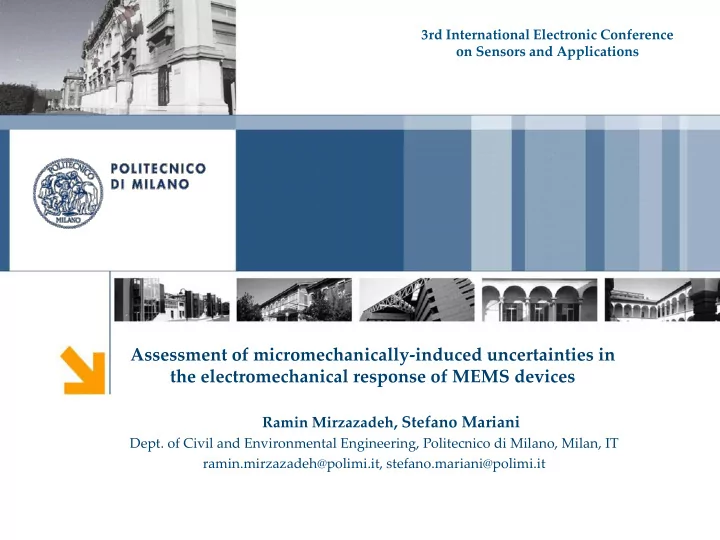

3rd International Electronic Conference on Sensors and Applications Assessment of micromechanically-induced uncertainties in the electromechanical response of MEMS devices Ramin Mirzazadeh , Stefano Mariani Dept. of Civil and Environmental Engineering, Politecnico di Milano, Milan, IT ramin.mirzazadeh@polimi.it, stefano.mariani@polimi.it
Motivation MicroElectroMechanical Systems (MEMS) miniaturization and reliability Polysilicon a popular material in MEMS fabrication Anisotropic crystalline material whose material properties depends on the relative orientation to the crystal lattice Characteristic length of mechanical components can be www.sandia.gov compared to the size of grains Morphology & crystal lattice orientation Sources of uncertainties in device static/dynamic response As the Characteristic length of mechanical components decreases the effects of fabrication inaccuracies emerge Hopcroft,M.A .,et.al.,“What is the Young Modulus of Silicon?”, JMEMS ,2010 Type & amplitude of these fabrication imperfections R. Mirzazadeh 2
Experiments design Electrostatic actuation/sensing Microcantilever 4 testing configurations in a simple design Rotational capacitors g 0 = 2 μ m Actuation Designed gap h = 2 μ m Designed beam thickness l = 20 μ m Beam length Lateral capacitor R. Mirzazadeh 3
Experiments design Electrostatic actuation/sensing Microcantilever 4 testing configurations in a simple design g 0 = 2 μ m Designed gap h = 2 μ m Designed beam thickness l = 20 μ m Beam length R. Mirzazadeh 4
Experiments 10 specimens are tested Capacitance changes in order of few fF l = 20 μ m www.ipms.fraunhofer.de Scattering of electromechanical reseponses R. Mirzazadeh 5
Formulating uncertainty sources Formulating the problem • Young’s modulus, E • Overetch, O Initial rotation, 𝜄 0 • R. Mirzazadeh 6
Analytical modelling • Assumption: negligible electric fringe field , perfect anchor Euler Bernoulli Timoshenko Electrostatic potential Unit electrostatic force Unit capacitance Similar expressions for capacitance changes at two sets of capacitors R. Mirzazadeh 7
Parameter identification Genetic algorithm • • Parameter identification using a genetic algorithm Formulating the problem • Population of 5000 individuals, and 11 generations • Young’s modulus, E • • Two actuation types for cross-validaiton Overetch, O Initial rotation, 𝜄 0 • R. Mirzazadeh 8 8
Parameter identification Genetic algorithm Consistent estimations Inconsistent estimations capacitance change (fF) capacitance change (fF) 4 0.5 3 Introducing three 0 2 uncertain parameters into -0.5 the model enhaced the 1 parameter estimation 0 -1 0 10 20 30 40 0 5 10 15 V R (V) V L (V) process with respect to the capacitance change (fF) 0 capacitance change (fF) 2.5 previous work* 2 -2 1.5 1 -4 Numerical Simulated 0.5 Experimental Experimental *Mirzazadeh R., Ghisi A., Mariani S., “Assessment of -6 0 polysilicon film properties through on- chip tests”, Proceedings 0 10 20 30 40 0 5 10 15 V L (V) V R (V) of Sensors and Applications, November 2015. R. Mirzazadeh 9
Conclusion Concluding remarks: • An on-chip testing device is designed in order to characterize the main features of MEMS fabricated by polycrystalline materials with cross-validation capability. • Experimental evidence on the scattering of micro beams electromechanical response when their characteristic length shrinks. • Analytical coupled-field models are provided for electrostatic MEMS. Appropriate models can be developed for other MEMS devices similar to what has been proposed in this work. • Material and geometrical parameters of the devices have been characterized through genetic algorithm. Possible future developments • Adopting numerical models such as FEM for more sophisticated modelling of the device. • Employing probabilistic tools (such as Bayesian inference based methods) for parameter identification to allow for measurement errors References: Mirzazadeh, R., Eftekhar Azam, S., Mariani, S.: Micromechanical Characterization of Polysilicon Films through On-Chip Tests. Sensors, 16, 1191, 2016. Mirzazadeh R., Ghisi A., Mariani S., “Assessment of polysilicon film properties through on - chip tests”, Proceedings of Sensors and Applications, November 2015. Younis M.: MEMS Linear and Nonlinear Statics and Dynamics. Springer Science+Business Media, 2011. Hopcroft M. A., Nix W. D., Kenny T. W.: What is the Young’s Modulus of Silicon? J Microelectromech Syst 19: 229-238 2010. R. Mirzazadeh 10
Recommend
More recommend